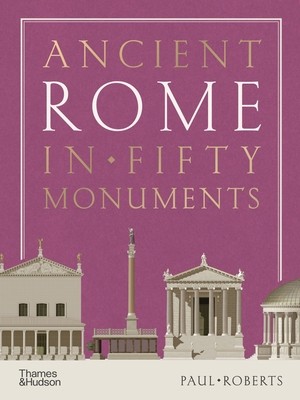
- We will send in 10–14 business days.
- Author: Paul Roberts
- Publisher: Thames & Hudson
- ISBN-10: 0500025681
- ISBN-13: 9780500025680
- Format: 19.3 x 25.2 x 3.1 cm, hardcover
- Language: English
- SAVE -10% with code: EXTRA
Reviews
Description
Rome wasn't built in a day, but over several centuries and under many different emperors. This story of continual creation and renewal lies at the heart of Ancient Rome in Fifty Monuments. Rome's history has been explored by countless classicists, historians, poets, and authors, but rarely has its history been recounted through the building programs of its emperors, which transformed a small village in Italy into the apogee of empire.
Paul Roberts takes the reader on a historical tour of ancient Rome, from the luxurious bathhouses of Caracalla and Diocletian, the rowdy Circus Maximus, and the Colosseum to monuments such as the Column of Trajan that celebrated Rome's imperial project. Roberts expertly weaves together the latest archaeological research with social and cultural history, vividly evoking the story of a city always in some way rising, falling, and being rebuilt.
He tells this story emperor by emperor, seeking out the personalities behind the great building projects and the very human motivations that gave rise to their construction--and destruction. When and why were they built? What did they add to the lives of the people who used them? What impact did they have on the shape of the city? Often the importance of a monument lies not intrinsically in the structure itself, but instead in the political, social, or cultural developments at its foundations. Through these monuments and the emperors who built them, Rome's mythical and real past are intertwined, reflecting the empire's triumphant yet often turbulent history.
EXTRA 10 % discount with code: EXTRA
The promotion ends in 20d.02:02:06
The discount code is valid when purchasing from 10 €. Discounts do not stack.
- Author: Paul Roberts
- Publisher: Thames & Hudson
- ISBN-10: 0500025681
- ISBN-13: 9780500025680
- Format: 19.3 x 25.2 x 3.1 cm, hardcover
- Language: English English
Rome wasn't built in a day, but over several centuries and under many different emperors. This story of continual creation and renewal lies at the heart of Ancient Rome in Fifty Monuments. Rome's history has been explored by countless classicists, historians, poets, and authors, but rarely has its history been recounted through the building programs of its emperors, which transformed a small village in Italy into the apogee of empire.
Paul Roberts takes the reader on a historical tour of ancient Rome, from the luxurious bathhouses of Caracalla and Diocletian, the rowdy Circus Maximus, and the Colosseum to monuments such as the Column of Trajan that celebrated Rome's imperial project. Roberts expertly weaves together the latest archaeological research with social and cultural history, vividly evoking the story of a city always in some way rising, falling, and being rebuilt.
He tells this story emperor by emperor, seeking out the personalities behind the great building projects and the very human motivations that gave rise to their construction--and destruction. When and why were they built? What did they add to the lives of the people who used them? What impact did they have on the shape of the city? Often the importance of a monument lies not intrinsically in the structure itself, but instead in the political, social, or cultural developments at its foundations. Through these monuments and the emperors who built them, Rome's mythical and real past are intertwined, reflecting the empire's triumphant yet often turbulent history.


Reviews